A while ago we hosted a webinar where we discussed the top 10 Shopify store mistakes that may be hurting sales. This was the first in a series of upcoming webinars, designed to educate you and your team about potential mistakes and opportunities in your marketing strategy.
If you’d like to watch the full webinar, you can do so by clicking the button below. For those of you who prefer reading blog posts over watching videos, this one is just for you.
Note: The first five mistakes are related to advertising, while the remaining ones are some of the most common business mistakes.
If you’d like to watch the full webinar, you can do so by clicking the button below. For those of you who prefer reading blog posts over watching videos, this one is just for you.
SHOPIFY STORE ADVERTISING MISTAKES
First, let’s start with Shopify store advertising mistakes.
Advertising mistakes are errors or missteps that can happen when creating and running ad campaigns. Some common ones include not targeting the right audience, having unclear or unconvincing messages, not paying attention to mobile users, and not analyzing how well the ads are doing.
It’s also a mistake to overlook feedback from customers or set unrealistic goals. To avoid these errors, it’s important to learn from experiences, adapt to changes, and always keep an eye on how your ads are performing.
Let’s discover each of one advertising mistakes!
Facebook Ads setup
The first Shopify store advertising mistake is the wrong ad setup.
Successful Google and Facebook advertising starts with the right ad account setup. So to start off, let’s go through some of our tips for setting up your ad account.
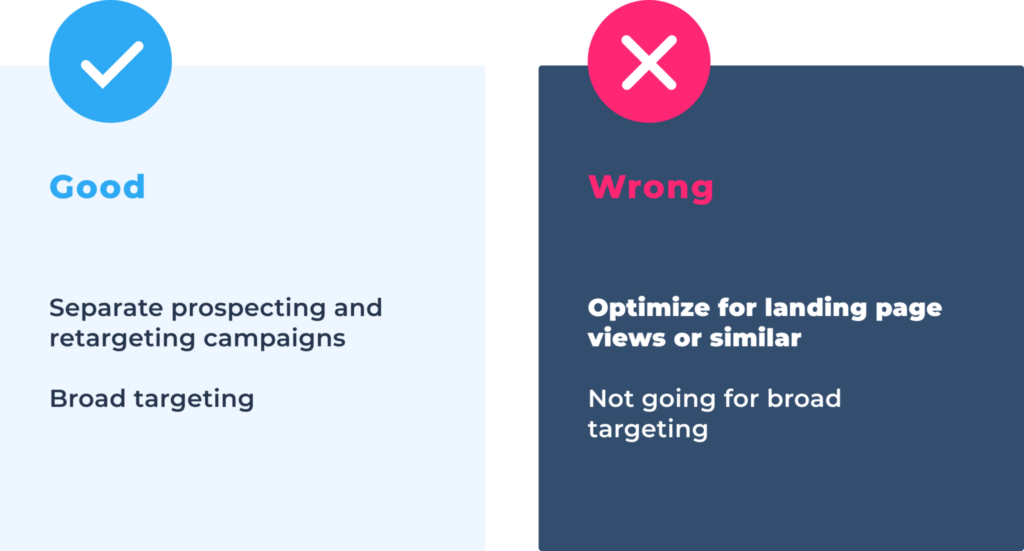
The first tip we like to emphasize is to simplify your account setup. Essentially, you only need two campaigns in your Facebook ad account – one for your retargeting audience and one for your prospecting audience.
The whole point is to have a comprehensive look at your campaigns, with data that you can conclude.
Retargeting audience: people who visited your website in the last 60 days but haven't purchased yet.
Prospecting campaigns: people who aren't familiar with your brand or products/services.
Similarly, you don’t want to have a bunch of different ad sets in your campaigns. We always recommend having three to a maximum of five ad sets per campaign, as well as one ad per ad set.
Also, make sure to separate your ad sets by creative type so that you can better understand what’s resonating with your target audience.
What about Facebook targeting?
If you’re familiar with all the available targeting options on Facebook, you know that you have three options to choose from:
- Lookalikes
- Interest targeting
- Broad targeting
In the past couple of years, lookalikes were considered the best performers, but as of today, almost every client we work with is using broad targeting.
And that comes as no surprise since Facebook is becoming smarter and smarter – being able to find your ideal customers with minimal information.
Generally, with Facebook Ads, we found that the less restriction we put on the algorithm, the better is the performance in terms of customer acquisition cost (CAC), and conversion rate (CR).
Which optimization event should you use?
Another key tip we like to emphasize when setting up your campaigns is using the right optimization event.
Long story short: always optimize for conversions!
Why?
When optimizing for landing page views, you’re basically telling Facebook to find people who are most likely to click on your ad and then visit your website.
But even if a lot of people land on your website that doesn’t necessarily mean they are going to purchase something.
Facebook gives you what you ask for. So if your goal is to generate as many purchases, what’s the point of using the landing page view optimization?
We tested this over and over again on multiple ad accounts and when optimizing for conversions we ALWAYS achieved better performance. You can see from the a/b test results below that the customer acquisition cost (CAC) was 90% lower, the conversion rate (CR) was x13 higher and the bounce rate was lower when optimizing for conversions.
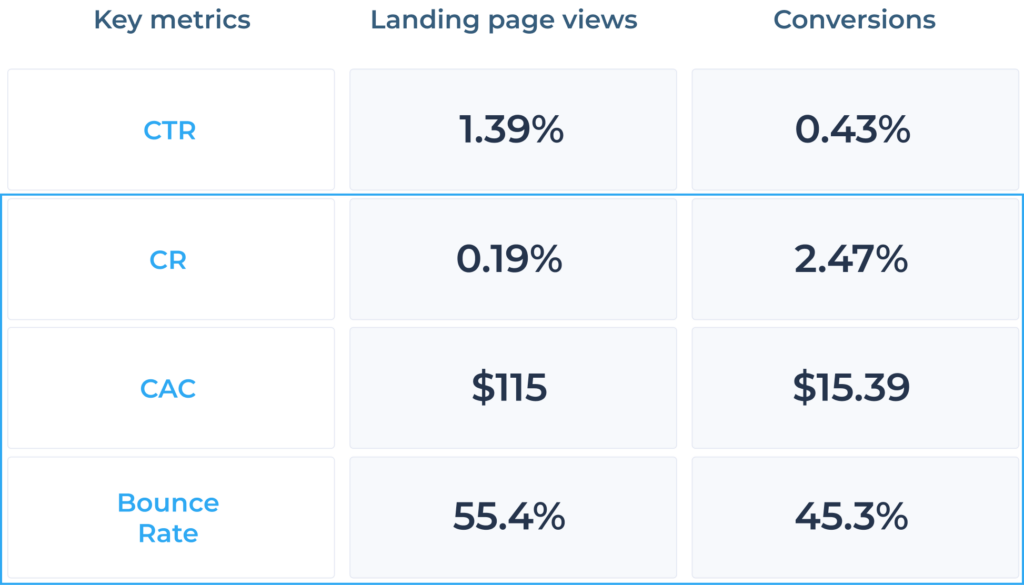
Not utilizing the whole anatomy of an ad
When talking about the anatomy of an ad, there are five different elements you can choose to utilize:
- primary ad text,
- visual,
- call to action button (CTA),
- headline,
- description.
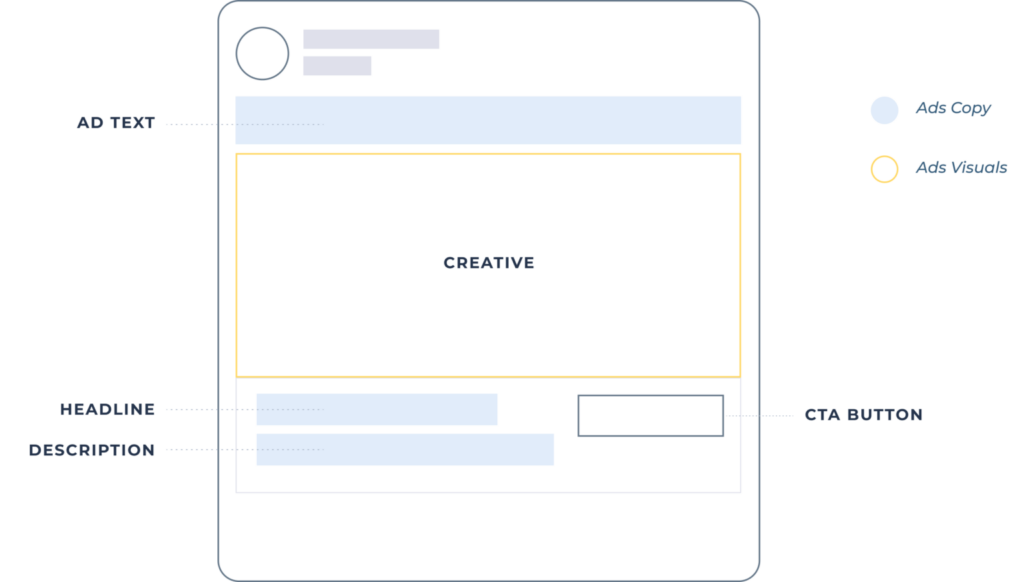
We always recommend utilizing all the available elements of an ad so you’re sure that you’re not leaving performance on the table.
For the call to action button, we always recommend going for “Shop now” as it always performs best for e-commerce businesses.
We also have some tips for creating a high-converting visual, ad copy, and description that we’re going to mention later on in the blog post.
Which ad placements should you use?
Since we’re talking about the anatomy of an ad, we can’t forget to mention ad placements.
In case you don’t know what ad placements are it’s the location where your ad can be shown. For example, Instagram stories, Instagram feed, Audience Network, Facebook Messenger, etc.
When creating new ad sets, Facebook gives you the option to choose between manual and automatic placements (now called Advantage+ placements).
What we usually see is businesses using manual placements and, therefore, limiting their ads to just a couple of different placements. By doing this, they’re putting a lot of restrictions on the algorithm, making it hard for it to make the most out of the budget.
With automatic placements, Facebook allocates your ad set’s budget across multiple placements based on where they’re likely to perform best.
So if a certain placement is not performing well, the algorithm is going to focus on the opportunities across other available placements.
We ran multiple a/b tests and have always found that using automatic placements significantly lowers the CAC and CPC.
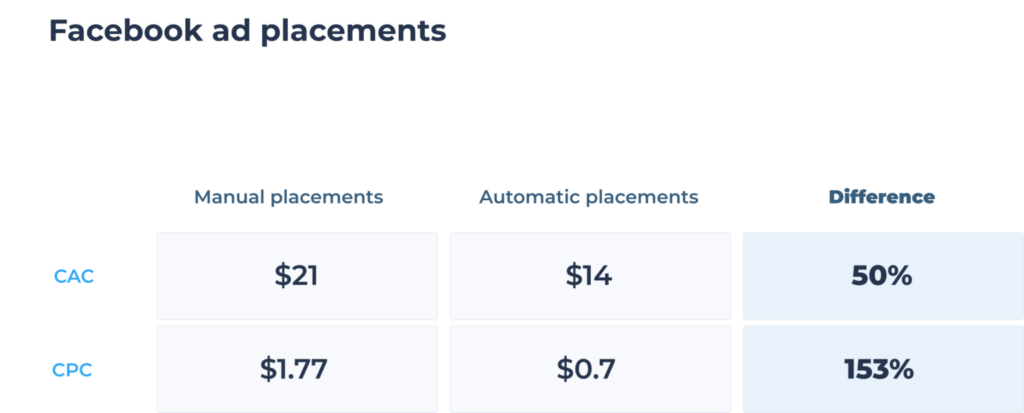
Facebook Ads copy
With prospecting campaigns, we’ve seen that mentioning the price and free shipping positively impacts the ROAS, while creating a sense of urgency, and using social proof decreases it.
Some of you might be surprised by these results, but when you think of it, it makes a lot of sense. A cold, prospecting audience is still not familiar with your brand or products. Therefore, creating a sense of urgency and pushing them to buy something they don’t know much about is going to negatively impact their purchasing decision and your ROAS.
The same applies to using social proof. Until you introduce your products and your core benefits to your cold audience, there is no point in showing them any social proof.
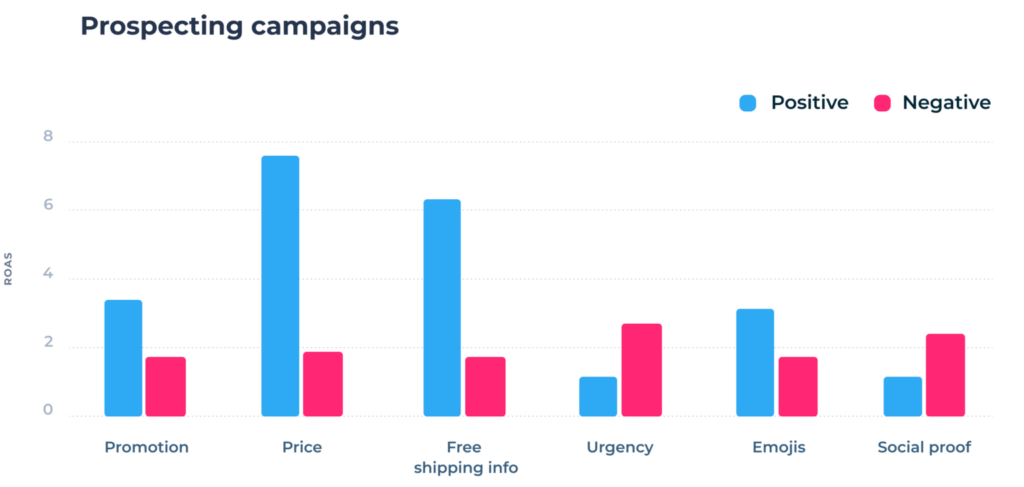
Refers to mentioning free shipping and/or returns.
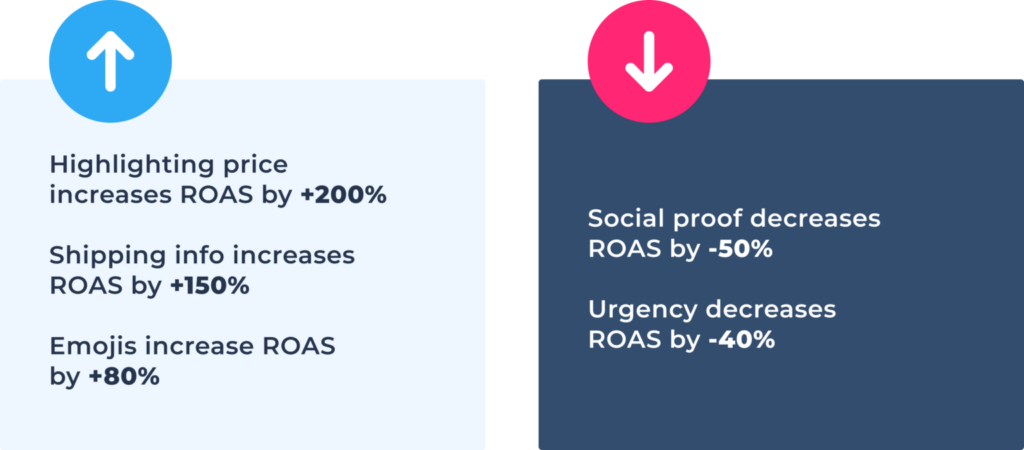
While urgency and social proof don’t work on prospecting campaigns, we can see that both of those work wonders on remarketing campaigns.
Emojis are also huge on both prospecting and remarketing campaigns as they add a more friendly and accessible tone to your ad copy.
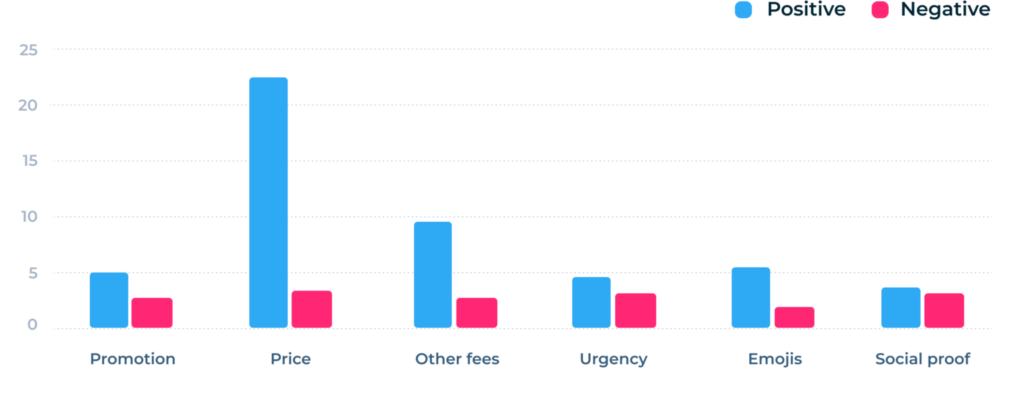
Refers to mentioning free shipping and/or returns.

Facebook Ads videos and images
The next Shopify store mistake refers to using the same ad creative for your prospecting and retargeting audience. As we previously mentioned, these two audiences are significantly different, therefore, they each require a different communication.
When creating the ad visual for your prospecting campaign, we recommend using lifestyle photos that are not entirely focused on your product.
On the flip hand, for your retargeting audience, good product shots are more than welcome as this audience already knows about your brand and kind of wants to explore your products more.
Also, try to avoid video ads. Yes, videos are engaging and probably more fun than a static image, but they usually have a much higher CPM (advertising price).
In fact, out of 10 top stores from our system, 9 of them aren’t using video ads. So this just proves that you can achieve the same or even better performance without using video ads.
What we do recommend, though, is to test out “5-star emojis” vs “free shipping” in your ad description.
As you can see from the table below, we tested three different options – no description, 5-star emojis, and free shipping.
The click-through rate (CTR) has been mostly the same on all three versions, but the conversion rate (CR) and return on ad spend (ROAS) on the ad with the 5-star emojis in the ad description has been the highest.
We tested this on many different accounts so we encourage you to test this as well.

To conclude this part, in the image below you can see a breakdown of some of the most important things you should be highlighting on your Facebook ads and website.
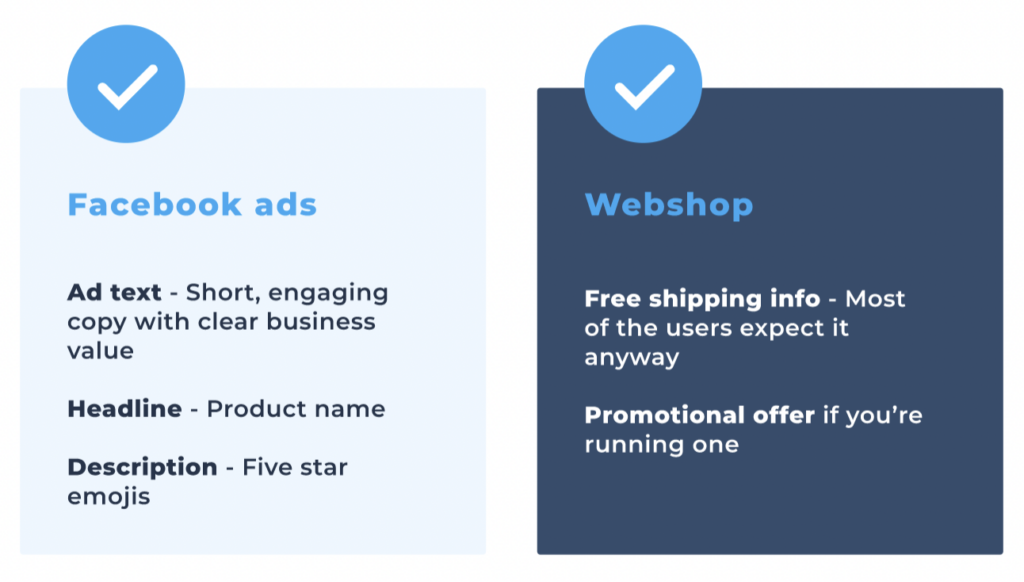
Incorrect Google Ads setup
Now let’s switch a bit to Google Ads and discuss some common mistakes and best practices you should be following.
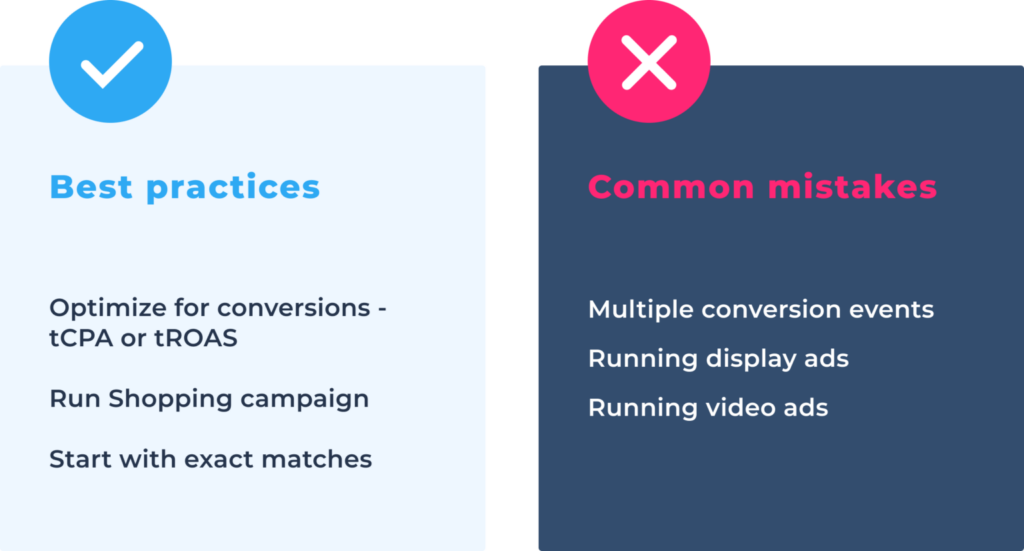
The first Google Ads mistake we see a lot of businesses make is tracking multiple conversion events.
Conversion tracking essentially allows you to track a specified action in your Google Ads account. For example, phone calls, app installs, purchases, email signups, etc.
When you don’t specify to Google which conversion event you want to track, Google counts every single conversion. Whether it is an email signup, a purchase, or an app install. Because of that, you might be overcounting your total number of purchases and misinterpreting the data you’re seeing in your account.
The other two major mistakes are running display ads and video ads. Over the years we tested both display and video ads on multiple ad accounts and never actually saw an increase in the number of purchases.
We found they work great in terms of raising brand awareness but if you don’t have a large advertising budget and your primary goal is to boost sales, we’d recommend avoiding them.
SHOPIFY STORE BUSINESS MISTAKES
When we refer to “business mistakes,” we are talking about errors, misjudgments, or oversights that businesses make in various aspects of their operations, strategies, or decision-making processes. These mistakes can have negative consequences and impact the overall performance, growth, and success of a business.
So, let’s see the most common Shopify store business mistakes.
Not measuring customer lifetime value (cLTV)
If you’re only focused on your ROAS and the initial order that a customer is going to be making on Facebook or Google, you’re going to be missing out on the potential additional revenue that these customers are making.
The truthful bid, described by a mathematical theorem, really is the best and optimal strategy in online advertising. Why we think this is a problem is because you can’t really run a successful campaign if you don’t know how much you can offer to acquire a customer.
How you can get around that is by knowing how much money you’re going to earn from your customers in the long run.
While on the topic of your customers and how much revenue they are bringing in through time, it is important to focus on customer acquisition channels since not all customers are created equal: some are more profitable than others depending on whether they come from Facebook, Google, or email.
Not taking the impact of ads on organic results into account
When you spend money on Facebook and Google ad campaigns, you usually have easily measurable results. But what we want to see when we’re putting more money into ad campaigns is the rise of brand awareness. Don’t let this point mislead you, always use conversion-optimized campaigns, not brand awareness campaigns because it will still organically increase your brand awareness.
When you have more brand keyword searches, you are going to have more organic conversions. In other words, you aren’t going to have to pay as much to acquire the customers that are going to be searching for your brand organically.
The conversion rate on brand keyword searches is always going to be around 15% and if you spend, let’s say, $30,000 on advertising, be it on Facebook or Google or other ad channels, you will usually see around 9,000 brand-related keyword searches on Google.
While taking into account that the CTR should be around 40%, we’re talking about 3,600 additional visitors per month or 540 conversions assuming the CR is 15%.
Increasing the spend on ads will increase brand awareness as well, leading to more organic conversions and higher overall ROI.
Misled reporting
When Facebook is overcounting purchases, in comparison to Shopify orders, it means that the conversion tracking is not set up correctly. If you don’t have all the data placed in one place, you are not going to be aware of how well or how bad your Facebook or Google ad campaigns are performing.
Why does overcounting happen? Due to the conversion API, Facebook Pixel, and the iOS 14.5 update that is occurring right now.
Facebook and Google ads should impact first-time Shopify orders. This is very important simply because there are much cheaper channels to reach out to your existing customers. Emails are great to reach out and trigger a repurchase instead of burning through your ad budget on retargeting.
Not learning from your competitors
A big mistake that businesses make is that they are just not paying attention to what their competitors are doing; not keeping any tabs on their activities.
When you find that one competitor in your space that is big and fast-growing, you should look at their ads and marketing strategies, and if you find something that is functioning well, there is no shame in copying good-performing ads.
This is particularly true if your business is expanding globally – analyzing your global competitors and their strategies can help you understand what works and what doesn’t in other markets.
Use the best practices that your competition is already using and boost your growth. Every month take one day to analyze what they’re doing, how they’re growing, and which strategies they’re using.
Not analyzing your checkout funnel
And the last Shopify store business mistake is not analyzing your checkout funnel.
Your ads will perform as well as your website does. You can have the best ads in the world, but if the customers who land on your website find it hard to complete a purchase, they won’t end up buying.
Your CTR, CPM, and marketing strategy could be phenomenal, but if your store is not performing, you aren’t going to see much revenue.
It’s important to focus on the steps that have the highest opportunity for improvement and that would be your “Add to Cart” rate, “Checkouts Initiated” rate, and “Purchase” rate.
By identifying and fixing your funnel mistakes, you will achieve a higher ROAS because your website works in conjunction with your Facebook and Google ads.
Summing Up
Now that you’re familiar with some of the most common Shopify store mistakes and know how to avoid them, it’s time to start optimizing and boosting those conversions.
We hope you found our insights useful and that you’ll put some of them to the test. In case you’d like to watch the full webinar or go over the slides, simply hit the button below.
If you have any questions regarding the webinar or your ad performance, feel free to drop us a line at [email protected]. We are always happy to help and discuss the best way of optimizing your campaigns.



